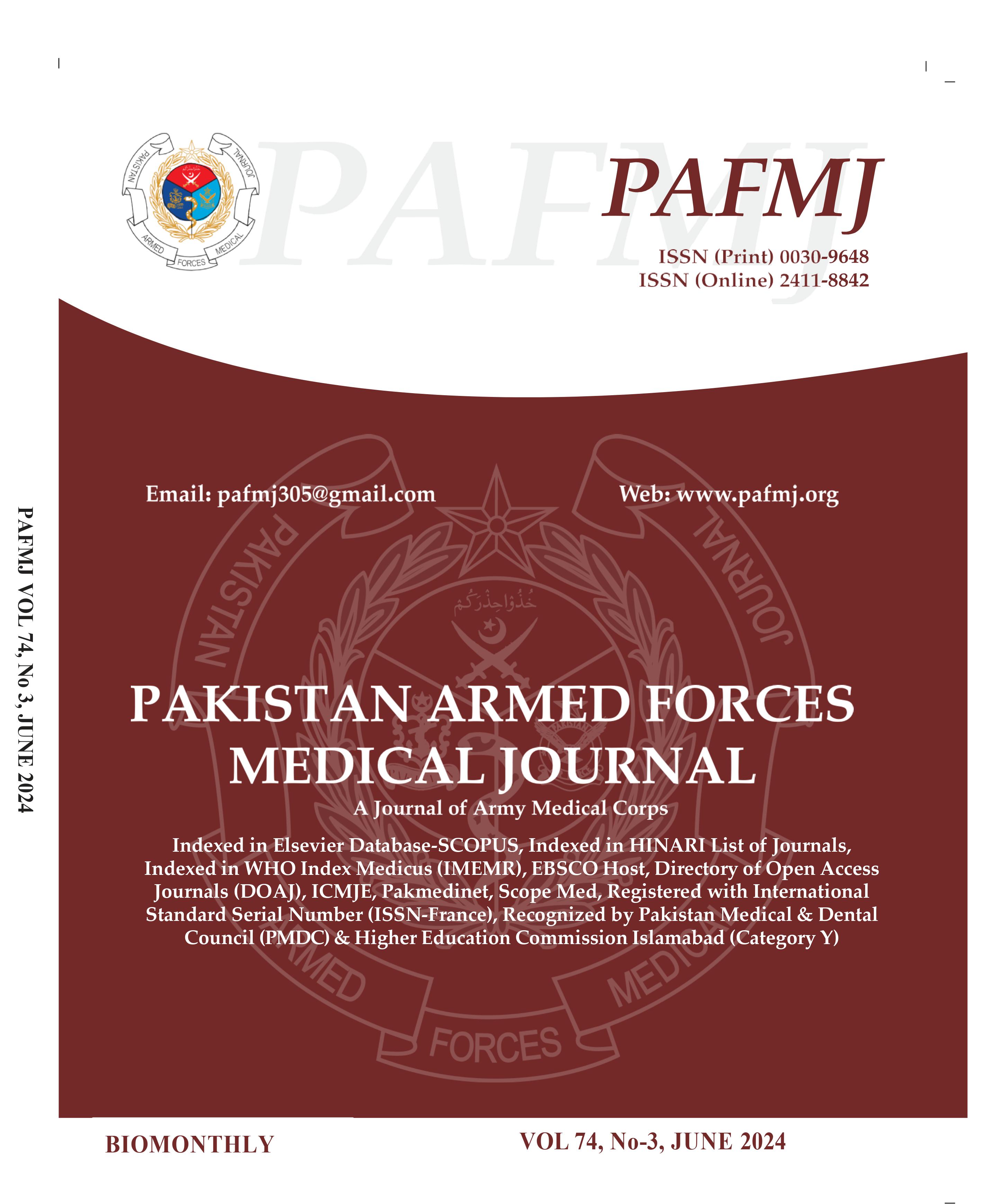Evaluation of Antithrombin-III Deficiency and Factor V Leiden Mutation in Patients with Stroke in Young Patients
DOI:
https://doi.org/10.51253/pafmj.v74i3.6629Keywords:
Antithrombin III, Comorbid, Factor V leiden, Ischemic strokeAbstract
Objective: To evaluate Antithrombin III and Factor V Leiden mutation in stroke among young patients and its association with various socio-demographic aspects.
Study Design: Cross-sectional study.
Place and Duration of Study: Pak-Emirates Military Hospital, Rawalpindi Pakistan, from Jan to Dec 2020.
Methodology: A total of 103 individuals, aged 18-65 years, with acute ischemic stroke were included. The diagnosis was confirmed using computed tomography/Magnetic Resonance Imaging Brain scan. Plasma AT III activity and Factor V Leiden mutation were analyzed using standard techniques. Various socio demographic features like age, gender, body mass index, smoking, deployment at High altitude (>10,000 feet), family history of stroke and hyperlipidemia were recorded and statistically analyzed.
Results: Only two (1.9%) patients had AT III deficiency while one (0.9%) patient showed Factor V Leiden mutation. All patients were male. Working at high altitude, family history of stroke and tobacco smoking were related with the presence of low AT III levels (p-value <0.05).
Conclusion: Testing for hypercoagulable states in the setting of stroke in young may be useful if there is family history of stroke, smoking and high-altitude deployment. Investigations to search for the cause should be tailored as per individual patients.
Downloads
References
Feigin VL, Norrving B, Mensah GA. Global burden of stroke. Circ Res 2017; 120(3): 439-448.
https://doi.org/10.1161/CIRCRESAHA.116.308413
Khan MI, Khan JI, Ahmed SI, Ali S. The epidemiology of stroke in a developing country (Pakistan). Pak J Neurol Sci 2019; 13(3): 30-44.
Bhosale VV, Singh S, Srivastava M, Pathak P, Prakash S, Sonkar S, et al. A case control study of clinical and biochemical parameters of metabolic syndrome with special attention among young and middle aged population. Diabetes Metab Syndr 2019; 13(4): 2653-2659.
https://doi.org/10.1016/j.dsx.2019.07.012
Ekker MS, Verhoeven JI, Vaartjes I, van Nieuwenhuizen KM, Klijn CJM, de Leeuw FE. Stroke incidence in young adults according to age, subtype, sex, and time trends. Neurology 2019; 92(21): e2444-2454.
https://doi.org/10.1212/WNL.0000000000007523
Markus HS, editor. Stroke genetics. Oxford: Oxford Medical Publications; 2003.
Corral J, de la Morena-Barrio ME, Vicente V. The genetics of antithrombin. Thromb Res 2018; 169 Suppl 1: S23-29.
https://doi.org/10.1016/S0049-3848(18)30078-1
Mann KG, Kalafatis M. Factor V: A combination of Dr. Jekyll and Mr. Hyde. Blood 2003; 101(1): 20-30.
https://doi.org/10.1182/blood-2002-05-1404
Ridker PM, Miletich JP, Hennekens CH, Buring JE. Ethnic distribution of factor V Leiden in 4047 men and women: implications for venous thromboembolism screening. JAMA 1997; 277(16): 1305-1307.
https://doi.org/10.1001/jama.1997.03540400045035
Chiasakul T, Jesus ED, Tong J, Chen Y, Crowther M, Garcia D, et al. Inherited thrombophilia and the risk of arterial ischemic stroke: A systematic review and meta-analysis. J Am Heart Assoc 2019; 8(19): e012877.
https://doi.org/10.1161/JAHA.119.012877
Pagana K, Pagana T, Pagana T. Mosby's Diagnostic & Laboratory Test Reference. 14th ed. St. Louis, Mo: Elsevier; 2019.
Khalid A, Khan SA, Alamgir W, Anwar R. Thrombophilia profile in young patients of cerebrovascular accident-an institution based study. Pak Armed Forces Med J 2018; 68(4): 701-705.
George MG. Risk factors for ischemic stroke in younger adults. Stroke 2020; 51(3): 729-735.
https://doi.org/10.1161/STROKEAHA.119.024156
Alakbarzade V, Taylor A, Scully M, Simister R, Chandratheva A. Utility of current thrombophilia screening in young patients with stroke and TIA. Stroke Vasc Neurol 2018; 3(4): 231-236.
https://doi.org/10.1136/svn-2018-000163
Lim MY, Deal AM, Kim S, Musty MD, Conard J, Simioni P, et al. Thrombophilic risk of individuals with rare compound factor V Leiden and prothrombin G20210A polymorphisms: an international case series of 100 individuals. Eur J Haematol 2016; 97(4): 353-360.
https://doi.org/10.1111/ejh.12721
Anadure R, Christopher R, Nagaraja D, Narayanan C. A genetic study of factor V Leiden (G1691A) mutation in young ischemic strokes with large vessel disease in a South Indian population. J Clin Neurosci 2017; 43: 346-352.
https://doi.org/10.1016/j.jocn.2017.05.012
Kim RJ, Becker RC. Association between factor V Leiden, prothrombin G20210A, and methylenetetrahydrofolate reductase C677T mutations and events of the arterial circulatory system: a meta-analysis of published studies. Am Heart J 2003; 146(6): 948-957.
https://doi.org/10.1016/S0002-8703(03)00426-0
Kohli R, Moliterno AR, Streiff MB, DeBaun MR, Kickler TS, Blakemore K, et al. Risk factors for pregnancy-associated venous thromboembolism: the role of maternal age, obesity, smoking and other modifiable risk factors. Blood 2018; 132(Suppl 1): 3804.
https://doi.org/10.1182/blood-2018-99-116789
Hossmann V, Heiss WD, Bewermeyer H. Antithrombin III deficiency in ischaemic stroke. Klin Wochenschr. 1983; 61(12): 617-620. https://doi.org/10.1007/BF01724844
Morris JG, Singh S, Fisher M. Testing for inherited thrombophilias in arterial stroke. Stroke 2010; 41(12): 2985-2990.
https://doi.org/10.1161/STROKEAHA.110.592873
Lasek-Bal A, Kopyta I, Warsz-Wianecka A, Puz P, Łabuz-Roszak B, Zaręba K. Risk factor profile in patients with stroke at a young age. J Neurol Res 2018; 40(7): 595-601.
https://doi.org/10.1007/s00415-018-8970-6
Jha SK, Anand AC, Sharma V, Kumar N, Adya CM. Stroke at high altitude. High Alt Med Biol 2002; 3(1): 21-27.
https://doi.org/10.1089/152702902753639485
Subha PP, Geethakumari SMP, Athira M, Nujum ZT. Pattern and risk factors of stroke in the young among stroke patients admitted in medical college hospital, Thiruvananthapuram. Ann Indian Acad Neurol 2015; 18(1): 20.
https://doi.org/10.4103/0972-2327.144286
Soliman RH, Oraby MI, Fathy M, Essam AM. Risk factors of acute ischemic stroke in patients presented to Beni-Suef University Hospital: prevalence and relation to stroke severity at presentation. Egypt J Neurol Psychiatr Neurosurg 2018; 54(1): 8.
https://doi.org/10.1186/s41983-018-0011-4
Putaala J, Metso AJ, Metso TM, Konkola N, Kraemer Y, Haapaniemi E, et al. Analysis of 1008 consecutive patients aged 15 to 49 with first-ever ischemic stroke. Stroke 2009; 40(4): 1195-1203. https://doi.org/10.1161/STROKEAHA.108.529883
Arif S, Hashmat A. Assessment of homocysteine levels in patients with stroke in young. Pak Armed Forces Med J 2019; 69(6): 1179-1183. https://www.pafmj.org/PAFMJ/article/view/3629
Downloads
Published
Issue
Section
License
Copyright (c) 2024 Hamad Khan, Khurram Haq Nawaz, Muhammad Asif Nizami, Hamid Mukhtar, Faisal Shabbier Sheikh, Muhammad Anjum

This work is licensed under a Creative Commons Attribution-NonCommercial 4.0 International License.















